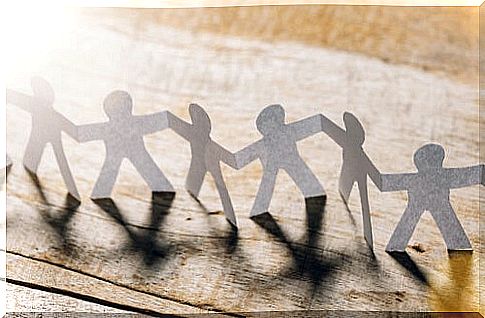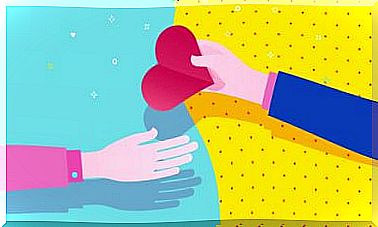Does Altruism Exist?

Altruism is one of the most important values or motives that govern social interaction. It seems to be closely related to solidarity and helping other people. In fact, when we are children, our survival is conditioned by the altruism of our own parents.
However, and outside of what is believed within popular culture, altruism is not totally free of reasons or motives. It does not emanate from the purest and absolute goodness of the human being.
This idea is based on numerous psychological studies and research whose objective was to clarify what exactly altruism is, where apparently altruistic and disinterested behaviors emanate from and under what conditions they arise.

Altruism or helpful behavior
Currently, psychologists use two different terms: altruism and helpful behavior. This last expression arises from a group of researchers who want to focus exclusively on behaviors that, objectively, help a third party; the reasons why that third party is helped do not matter.
Many seemingly generous and charitable acts are nothing more than the result of behavior of panic or euphoria. These emotions lead the individual to carry out a series of actions that are little related to the altruistic act, even if a third party benefits. Thus, although any altruistic behavior is helping behavior, not all helping behavior is necessarily altruistic.
Empathy and altruism
The discussion about the existence of the altruistic motive somehow emanates from the emotion that we believe should accompany that altruism. The origin of altruism could be traced in the emotion that causes it. This emotion, as Martin Hoffman (1975) concluded, could be called empathy.
The same author defines empathy as an affective response that is appropriate for the situation of another person other than ourselves. That affective response could later be translated into helpful behavior. Hafield, Cacioppo and Rapson (1993) talk about emotional contagion and how this is the fundamental component of empathic processes and the altruistic fact. Emotional contagion has two basic mechanisms:
- Regulators in non-verbal interaction : our interactions are characterized by tending to unconscious synchronization and imitation of the voice, movements and postures and expressions of our interlocutors.
- Facial feedback : some changes in our features can cause variations in our emotional experience. It has been studied for a long time, and this phrase perfectly illustrates the enigma of our emotions: are we crying because we are sad, or are we sad because we cry?
If we interact with someone who feels bad, it is easy for our facial expression to match that of the other, that is, it becomes synchronized. In turn, a process of facial feedback will take place, since the emotional state will change in a direction congruent with that of the other, and now with that of our facial expression.
Intrinsic Altruism: The Compassion Hypothesis
Batson (1979) identifies altruism with compassion, and defends that the altruistic act passes through several stages. Batson says that altruistic motivation is an end in itself and does not involve any benefit to the individual.
After the subject has felt that altruistic motivation, a hedonic calculation takes place, where a weighting of the consequences of the action is made, but this always occurs after having felt that prosocial motivation.
For Batson, therefore, altruism – which he calls compassion – is intrinsic, because helping behavior is satisfactory in itself: it does not seek anything beyond the interest of the other.
Extrinsic altruism: help with added benefits
Other authors, however, argue that altruism is extrinsic, that is, it is not satisfactory in itself. Satisfaction does not come exclusively from having helped a person, but rather because it brings added benefits or avoids certain costs. This weighting would be done without needing to feel compassion in advance.
Reinforcement seeking theory
Cialdini, Baumann and Kenrick (1981) argue that altruistic motivation is nothing more than a form of selfish motivation, although much more covert. No material gain is sought through it – this would clearly be selfish behavior and there would be no question about it. However, through the altruistic act certain symbolic reinforcements are sought .
Some of these can be prestige, improving self-image, or the personal satisfaction of complying with our values. Failure to help, in turn, can also lead to symbolic punishments, such as social disapproval or remorse.
Therefore, when you help a person not to feel bad later, or if you feel satisfaction in helping because you are complying with your own moral rule, that would not be intrinsic altruism. In fact, it is closer to achievement motivation than that kind of altruism.
Vicarious stress theory
Piliavin, Dovidio, and Gartner (1991) argue that helping behavior is designed to mitigate one’s own suffering, and not that of the other. This means that you want to calm your own emotional discomfort through the altruistic fact.
When observing the need in the other, an empathic process is produced that is aversive, since we see the other suffer. Strong negative emotions are therefore evoked for the subject himself. Sometimes you can avoid this situation by running away, but there are others that cannot. Therefore, we decided to help, to get rid of that discomfort.
Theory of uniqueness
Finally, Cialdini and Neuberg (1997) study helping behavior within uniqueness processes. There are studies that show that one’s identity is dynamic and malleable, that is, it changes throughout our lives.
On the other hand, the evolutionary current defends the cognitive and biological proximity between human beings. For this reason, we do not help the other because we are altruistic, but because the limits of our own identities merge and are confused with those of the other ; we are morphologically similar beings.
We feel similar and we live similar. This implies that we help the other to the extent that we confuse him with ourselves.

Is it bad to help looking for benefits?
It is possible that, depending on the circumstances, one or another of the aforementioned processes has a greater impact on our behavior. Therefore, the answer to the question of whether altruism exists should be answered with nuances.
Not all helping behaviors that are emitted are altruistic. In fact, it seems that few can pass the filter of socialization, hedonic calculation or the search for reinforcements to postulate as purely altruistic behaviors.
In this sense, the fact that a helping behavior seeks something more than helping the other is not bad. Likewise, although through the altruistic act one seeks, for example, to obtain the approval of a group, the truth is that there is still a third person, or even a group, who is helped.
So, without innocently falling into the idea that intrinsic altruism permeates all helpful behaviors, or at least many of them, it seems wrong to reject the hand of another because it seeks to respond to a personal interest . If we are helped, in many cases the motivation for that help might be indifferent.









